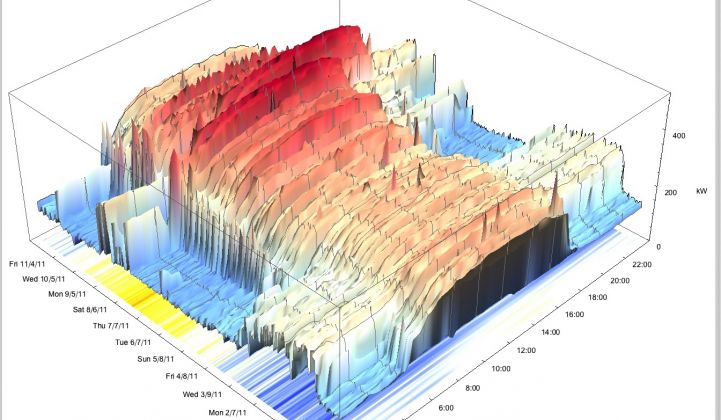Last year, we profiled Agilis, a Raleigh, N.C.-based early-stage company with some big customers using its software to find hidden inefficiencies and opportunities to improve building energy use. It’s one of many software efforts that fall under the category of “intelligent efficiency,” or using the latest IT tools to transform the way building energy is managed.
Last week, one of Agilis’ long-time partners revealed just how it’s building that software and analytics smarts into its large-scale customer outreach and services efforts. That’s HVAC giant Trane, which announced last week that Agilis is playing a core role in its Trane Energy Optics offering for commercial and industrial building customers.
Energy Optics starts with readily available data, such as interval meter data from utilities, weather and temperature data from the outside world, and occupancy and usage data from owners and tenants, to create an energy profile of the buildings in question.
While there are lots of different ways to visualize that information, the Agilis concept is based on some interesting new approaches. Here’s an example of some of those visualization tools, starting with Agilis’ trademarked three-dimensional graphic that shows how building use changes from day to day over the course of weeks or months:
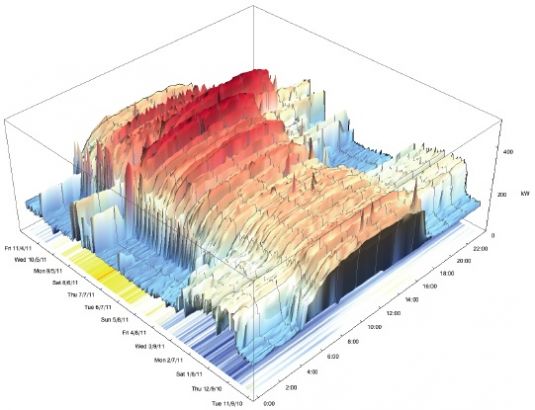
“At least in this industry, customers aren’t accustomed to this kind of approach,” Agilis CEO Joe Hirl said in a Monday interview. Trane and Agilis have been applying the tool first in the front end of customer engagement, to help them visualize where energy is being wasted as compared to ideal operating conditions.
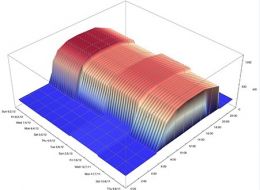

From there, experts at the two companies can help discern patterns of wasted energy, identify fixes and improvements, and identify savings between the two. The two partners have been working together in North America for about a year now, and have applied Energy Optics both to Trane’s own buildings and for customers such as office buildings, schools, municipal facilities, hospitals and manufacturers.
For Trane, the partnership represents a source of data and insight that can be handed over to its energy engineers and project developers to help grow its services business, according to Sean McBride, vice president of strategy and business development.
“We’re looking to cut through the complexity of the changing energy ecosystem for customers,” he said. “I think Agilis helps us really nicely in taking that data and turning it into a very simple set of reports.”
But measuring a building’s current efficiency status versus its ideal status is only the first step. The next step comes in calculating the costs involved in achieving the capital retrofits and fixes involved, or the changes in operations and maintenance practices needed to achieve them, Hirl noted.
Those principles can be applied to a range of situations, whether within a single building, or across a customer’s entire real estate portfolio, as the following graphic represents. Agilis and Trane have worked with an unnamed California city to analyze and rank all of its municipal properties in terms of energy efficiency potential and ROI, as well as several school districts.

Capturing and analyzing data doesn’t just help building owners and energy engineers figure out what’s wrong with a building and how to fix it, he added. It’s also critical in proving that the efficiency measures that have been taken are actually achieving the promised benefits.
That’s a task that’s not as simple as it sounds, considering that measuring efficiency gains requires measuring energy not used, he noted. That requires complex formulas to benchmark past performance against current performance, teasing out the weather, occupancy and other changes that have taken place in the intervening time. Here's one example, showing a view of energy usage during a set of Mondays in an Agilis-inspected building, both before and after it applied the efficiency measures suggested by the software's analysis.
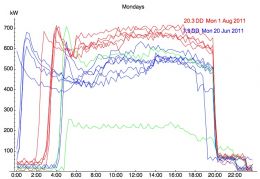
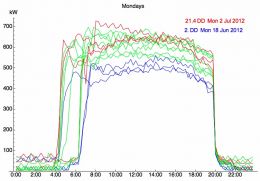
For Agilis, Trane offers a big opportunity to expand its business, as well as a new source of data from Trane’s massive installed base of HVAC and building energy equipment, Hirl noted. Agilis has applied its technology to about 1,100 buildings across North America, with customers including Constellation Energy, Boston Properties, Federal Capital Partners and KBS Realty Advisors. It is also starting to work in the U.K. with an unnamed energy services partner, he said.
There are lots of ways to use technology to improve the process of finding and achieving the energy efficiency potential locked inside buildings, of course. We’ve seen a number of early-stage and startup companies team up with major energy services vendors along these lines.
Some examples include Schneider Electric’s partnership with MIT spinout KGS, Johnson Controls tapping BuildingIQ’s HVAC optimization smarts, startups like Retroficiency and FirstFuel using data to pre-assess buildings for efficiency potential, or SkyFoundry licensing its building software to partners like Activelogix, Advanced Power Control, and Environmental Systems Inc., to name a handful.
Each has its own approach to the problem and tackles different parts of the process. That can range from detecting, diagnosing and correcting energy-wasting and equipment-degrading faults within building systems, to using data analytics to pick out the hard-to reach efficiency potentials and payoffs amidst the overwhelming number of buildings that are out there.
